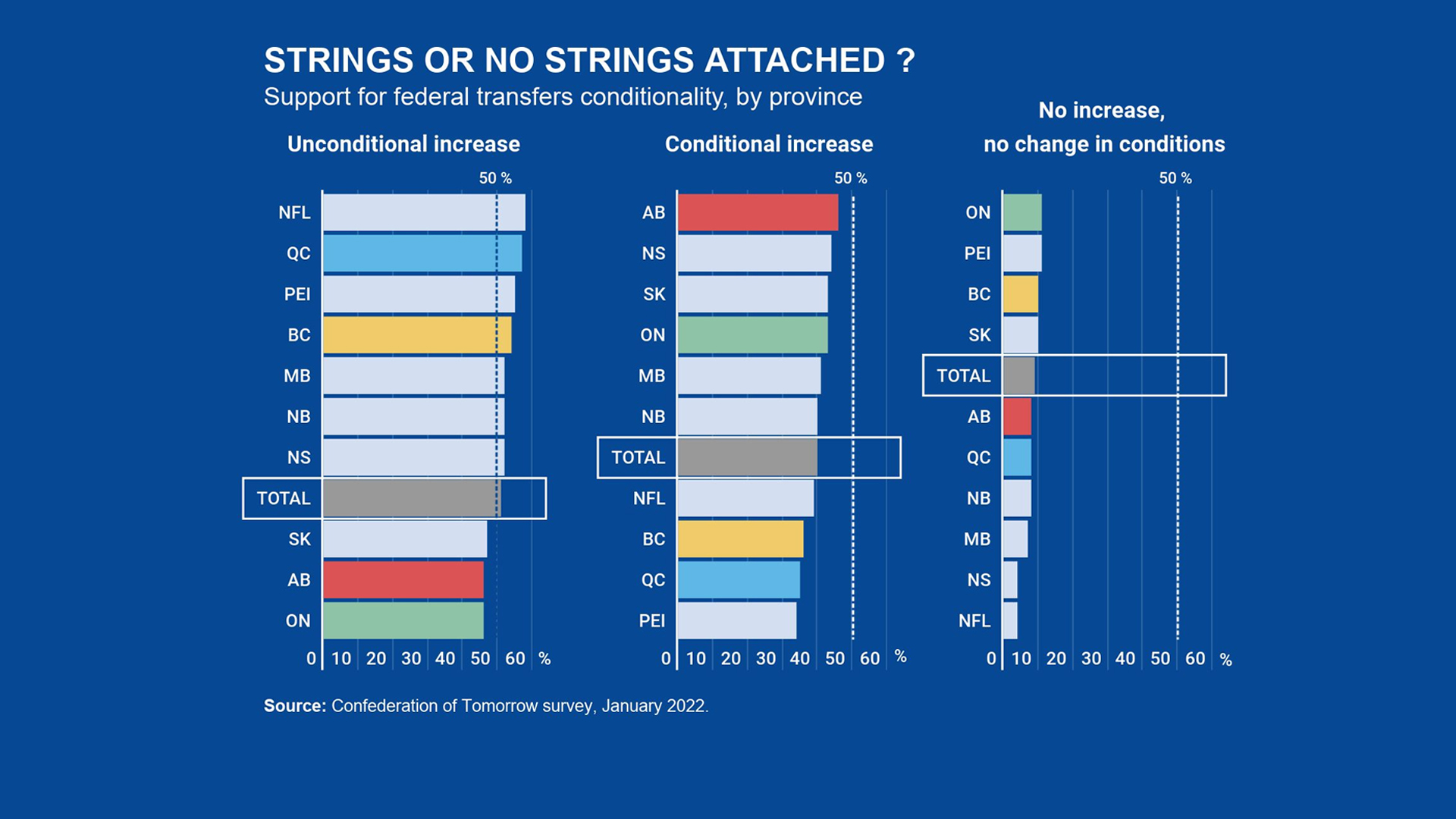
(Version française disponible ici.)
The COVID-19 crisis has revealed the vulnerabilities of the Canadian health-care system. A national conversation about the delivery, coverage and financing of health care will have to be held in the next few years. In Quebec, it has already been launched. Provincial governments propose an obvious solution: federal transfers for health care must increase to cover rising costs. Provincial premiers have called upon the federal government to immediately and unconditionally increase the share of health-care costs covered by the Canada Health Transfer (CHT) from 22 per cent to 35 per cent and to increase the transfers from $41.9 billion in 2020-21 to $69.5 billion for 2021-2022.
Unsurprisingly, the federal government sees things differently. While provincial governments would reap the benefits of higher transfers, a significant increase in transfers entails large fiscal costs and would force Ottawa to bear political costs by increasing deficits, raising taxes or cutting other federal spending. Moreover, the current transfer architecture leaves little oversight to Ottawa about how the additional funds are spent by provinces.
Hence, Ottawa prefers conditional transfers focused on specific areas considered as “national priorities” like mental health and long-term care for older people.
What do Canadians think of this debate about the future of health care funding between Ottawa and the provinces?
The Confederation of Tomorrow survey conducted in January 2022 by the Environics Institute for Survey Research, in partnership with the Canada West Foundation, the Centre d’Analyse Politique-Constitution et fédéralisme, the Institute for Research on Public Policy and the Brian Mulroney Institute of Government, helps answer this question. More than 5,000 respondents in all provinces and territories participated in the survey.
Big changes are coming to health and social programs
What will the federal government and the provinces argue about in 2022?
When will Canadian health care fully ride the digital connectivity wave?
We told respondents that the federal government transfers money to the provinces to pay for health-care services and that as the costs of public health care are increasing, provincial governments are asking the federal government to raise the amount of money it transfers to the provinces. We then asked respondents whether the transfers should increase, decrease or stay the same (respondents who don’t know are excluded from the analysis).
To mirror the trade-offs that Ottawa’s policy-makers face, we reminded one-third of respondents that higher transfers could lead to tax increases. We reminded another third of respondents that higher transfers may increase the federal deficit. The final one-third of respondents was asked about their preferences regarding transfers without referring to taxes or deficits.
Figure 1 reveals that support for higher transfers falls from 78 per cent in the unconstrained scenario to 61 per cent when transfers are funded by deficits and to 56 per cent when tax increases are mentioned. The proportion of respondents who choose to maintain or decrease the level of transfers doubles in the tax-increase scenario.
Figure 2 reveals that support for higher transfers is high among voters of all parties (in the 2021 federal election). In the unconstrained scenario, support ranges from 72 per cent among Conservative voters to 88 per cent among Bloc voters. It’s down to only 48 per cent among the Conservatives when taxes are mentioned, but keeps at least support of two-thirds of other parties’ voters.
Figure 3 reveals that support is high in all provinces, although it is higher in less-wealthy provinces, which are the most dependent on federal transfers. Support drops below 50 per cent in Alberta and Saskatchewan when tax increases are mentioned.
In brief, support for higher transfers declines significantly when their costs are revealed to respondents, but the majority of Canadians support additional health-care transfers even if it means higher taxes or deficits.
With or without conditions?
There is much less consensus among the public when assessing whether federal transfers should be offered conditionally or unconditionally. Respondents could choose whether they prefer the federal government to provide more funding to the provinces and let each province decide how to spend the money to improve services (unconditional transfers) or whether the federal government should create a single set of national standards and then provide more funding only to those provinces that meet those standards (conditional transfers). Respondents had a third option: no changes to current transfers. This option was chosen by only nine per cent of respondents, which reflects the popularity of the idea of increasing health transfers.
Although a slight plurality prefers to increase transfers unconditionally in every province, at least a third of respondents prefer to increase transfers conditionally. Support for higher transfers without condition is highest in Quebec, Newfoundland and P.E.I. and lowest in Ontario and in Alberta. Surprisingly, support for conditional transfers is also highest in Alberta. In that province, the population seems perfectly divided on the issue (46 per cent for conditional transfers, and 46 per cent against).
Obviously, respondents who trust provinces more to “make the right decisions in managing the health care system” are more likely to prefer unconditional transfers than those who believe Ottawa is more competent in health care.
Partisan cleavages about the conditionality of health-care transfers are particularly acute. Figure 5 reveals that a majority of NDP voters prefer conditional transfers, whereas a majority of Conservative voters prefer unconditional transfers. We also find a similar result if we measure ideology by asking respondents to situate themselves on a scale from left to right: the left prefers conditional transfers, whereas the right unconditional transfers.
The respondents who are the most in favour of conditional transfers are NDP, Green and Liberal voters living in provinces led by Conservative governments in Alberta, Ontario, Manitoba, and Saskatchewan (55 per cent in favour of conditional transfers and only 37 per cent in favour of conditional transfers).
These voters may share Ottawa’s fears: provinces are under no obligation to increase the health-care budget by the same amount as the additional transfers. Conservative provincial governments can spend higher transfers on tax cuts rather than use them to improve services. Others could choose to allocate these funds according to their own priorities, and not those of Ottawa (for example, to reduce waiting lists for surgical procedures). In the NDP-led British Columbia, in contrast, support for an unconditional increase in transfers is higher among voters of all federal parties than support for conditional transfers.
On the issue of fiscal federalism, Quebec has more affinity with the Canadian right than with the left. Not only are Bloc voters on the whole most in favour of unconditional transfers, but we see a cross-party support for higher and unconditional transfers in Quebec. There are no significant differences between respondents self-identifying with the left or with the right with regard to transfers. However, NDP and Liberal voters are more likely to support higher conditional transfers than voters from other parties. However, their support for conditional transfers remains much lower than that of New Democrats and Liberals in other provinces.
We must address the human resources side of health care before the next pandemic
Innovation needs a home in health care
A sovereign wealth fund for our health care system isn’t far-fetched
Hence, in Quebec, the nationalist left and the right support unconditional transfers, whereas the federalists are less in favour of unconditional transfers.
This survey of Canadians’ opinions about federal health-care transfers reveals that the positions of both the provincial and the federal governments are supported by public opinion, or at least by the voters who support them. There is a broad consensus in favour of increasing transfers from Ottawa to improve our health-care systems. This support remains high even when voters are made aware of the costs they risk incurring, which supports the position of the provinces. In contrast, voters in English Canada who support the Liberal government or the New Democrats tend to support the position of the federal government to impose conditions on transfers.









